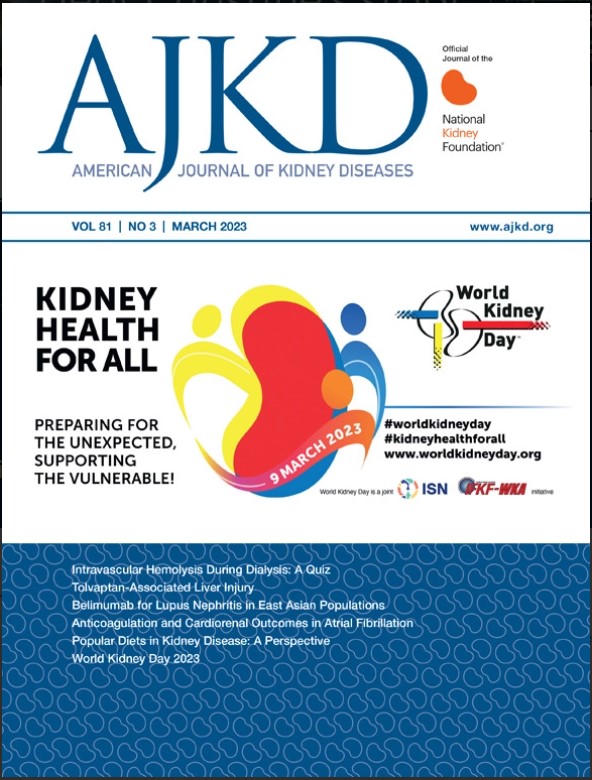Medical Suitability and Willingness for Living Kidney Donation Among Older Adults
IF 9.4
1区 医学
Q1 UROLOGY & NEPHROLOGY
引用次数: 0
Abstract
Rationale & Objective
The benefits of kidney transplantation compared with treatment with dialysis, including in older adults, are primarily limited by the number of donated kidneys. We studied the potential to expand the use of older living kidney donors.
Study Design
Secondary analysis of the Berlin Initiative Study, a population-based cohort.
Setting & Participants
2,069 adults aged ≥70 years in Germany.
Exposure
Age and sex.
Outcome
Suitability for living donation assessed by the absence of kidney-related exclusions for donation including albuminuria and low estimated glomerular filtration rate (eGFR) as well as absence of other medical exclusions. Willingness for living and deceased kidney donation assessed by participant survey.
Analytical Approach
Descriptive analysis.
Results
Among the 2,069 participants (median age 80 years, 53% women, median eGFR 63 mL/min/1.73 m2), 93% had ≥1 medical contraindication for living donation at study entry unrelated to eGFR or albuminuria. Using 2 published eGFR and albuminuria thresholds for donor acceptance, 38% to 54% of participants had kidney-related exclusions for donation. Among the 5% to 6% of participants with neither medical nor kidney-related exclusions for living donation at baseline, 11% to 12% remained suitable for donation during 8 years of follow-up. Willingness for living or deceased donation was high (73% and 60%, respectively).
Limitations
GFR was not measured, and medical exclusions unrelated to eGFR and albuminuria were assessed using a cohort database complemented by claims data.
Conclusions
One in 20 older adults were potentially suitable for living kidney donation, and willingness for living donation was high. Further studies are warranted to define the feasibility of expanding living kidney donation among older adults.
Plain-Language Summary
Although potentially beneficial, kidney transplantation remains infrequent among older adults aged ≥70 years with kidney failure. Study evaluated the potential to increase living kidney donation among older adults, including their medical suitability as well as willingness to donate. Among 2,069 community-dwelling older adults (median age 80 years), 5% to 6% had no exclusion to donation. Among these individuals, 11% to 12% remained suitable for donation during 8 years of follow-up. Most exclusions were not related to eGFR and albuminuria. Willingness to living donation was high (73%). These findings highlight the potential benefits from expanding the pool of transplantable kidneys through the use of living donation in older adults.

老年人的医疗适宜性和活体肾脏捐献意愿。
理由和目标:与透析治疗相比,肾移植的益处(包括对老年人的益处)主要受到捐赠肾脏数量的限制。我们研究了扩大使用老年活体肾脏捐献者的可能性:研究设计:柏林倡议研究(Berlin Initiative Study)的二次分析,这是一项基于人群的队列研究:暴露:年龄和性别:结果:活体捐献的适宜性根据是否存在与肾脏相关的捐献禁忌症进行评估,包括白蛋白尿和低估计肾小球滤过率(eGFR),以及是否存在其他医疗禁忌症。通过参与者调查评估活体肾脏捐赠和死亡肾脏捐赠的意愿:分析方法:描述性分析:在 2069 名参与者(中位数年龄为 80 岁,53% 为女性,中位数 eGFR 为 63 毫升/分钟/1.73 平方米)中,93% 在研究开始时有≥1 项与 eGFR 或白蛋白尿无关的活体捐献医疗禁忌症。根据已公布的两个接受捐献者的 eGFR 和白蛋白尿阈值,38% 至 54% 的参与者有与肾脏相关的捐献禁忌症。在基线时既没有因医学原因也没有因肾脏原因被排除活体捐献的 5% 至 6% 的参与者中,有 11% 至 12% 的人在 8 年的随访中仍然适合捐献。活体捐献或死亡捐献的意愿很高(分别为73%和60%):局限性:没有对肾小球滤过率进行测量,与肾小球滤过率和白蛋白尿无关的医疗排除是通过一个队列数据库并辅以索赔数据进行评估的:每 20 位老年人中就有一位可能适合活体肾脏捐赠,而且活体捐赠的意愿很高。有必要开展进一步研究,以确定在老年人中扩大活体肾脏捐献的可行性。
本文章由计算机程序翻译,如有差异,请以英文原文为准。
求助全文
约1分钟内获得全文
求助全文
来源期刊

American Journal of Kidney Diseases
医学-泌尿学与肾脏学
CiteScore
20.40
自引率
2.30%
发文量
732
审稿时长
3-8 weeks
期刊介绍:
The American Journal of Kidney Diseases (AJKD), the National Kidney Foundation's official journal, is globally recognized for its leadership in clinical nephrology content. Monthly, AJKD publishes original investigations on kidney diseases, hypertension, dialysis therapies, and kidney transplantation. Rigorous peer-review, statistical scrutiny, and a structured format characterize the publication process. Each issue includes case reports unveiling new diseases and potential therapeutic strategies.
 求助内容:
求助内容: 应助结果提醒方式:
应助结果提醒方式:


